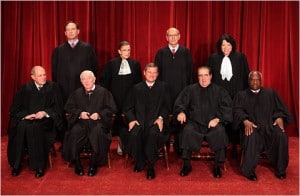Women will change the court
July 22, 2010
By David Broder, Washington Post
 Buoyed by a 13-6 vote in the Senate Judiciary Committee, Elena Kagan is on her way to the Supreme Court. The talk in Washington is what the impending elevation of the former Harvard Law School dean and solicitor general will mean for the capstone of the judiciary.
Buoyed by a 13-6 vote in the Senate Judiciary Committee, Elena Kagan is on her way to the Supreme Court. The talk in Washington is what the impending elevation of the former Harvard Law School dean and solicitor general will mean for the capstone of the judiciary.
Seated next to a former attorney general at a dinner party last weekend, I put the question to him – and received what is probably the conventional wisdom. “It won’t change anything,” he said, because Kagan’s moderate liberal philosophy is unlikely to deviate often from that of the justice she will replace, John Paul Stevens, often described as the leader of the four-member liberal minority. Not until one of the five conservative justices steps down will President Barack Obama have an opportunity to remake the judicial branch.
That is what they say, and I have no legal credentials to challenge their conclusion. But, as I told my dinner companion, I suspect he is wrong and that Kagan’s joining Justices Ruth Bader Ginsburg and Sonia Sotomayor on the bench will change the high court in ways that no one foresees.
I say this based on what I saw happen in the Washington Post’s newsroom and many others when women reporters and editors arrived, in increasing numbers, starting in the 1970s and ’80s. They changed the culture of the newspaper business and they altered the way everyone, male or female, did the work.
The women who came onto the political beat asked candidates questions that would not have occurred to us to ask. They saw their lives whole, while we were much more likely to deal only with the official part of it. So the scope of the candidate profiles expanded and the realm of privacy began to shrink.
They also changed the rules for reporters themselves. When I joined the press corps in the 1960 presidential campaign, I was formally instructed by a senior reporter for the New York Times on the “west of the Potomac rule.” What happened between consenting adults west of the Potomac was not to be discussed with bosses, friends and especially family members east of the Potomac.
It was a protective, chauvinistic culture, and it changed dramatically when more than the occasional woman reporter boarded the bus or plane.
I don’t know how having three strong-minded women justices serving simultaneously for the first time will change the Supreme Court. But I will be surprised if this small society does not change for all its members.
Click here to read the complete article.

